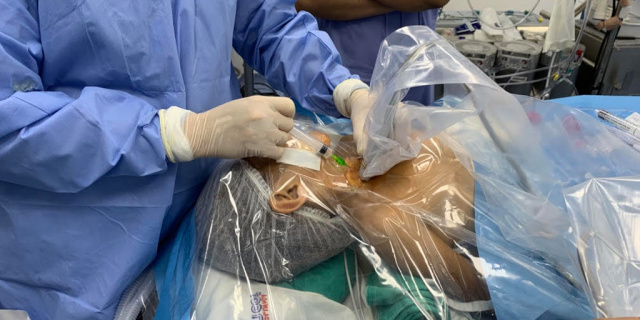

Pediatric cardiac anesthesiologist Dr. Pablo Motta MD, FAAP recently returned from Bolivia on a medical mission for HeartGift, developed through a partnership between by Texas Children’s Hospital and Memorial Herman Children’s Hospital, both located in Houston, Texas, and la Fundación Incor. in Santa Cruz, Bolivia. The goal of this mission is provide free, world-class pediatric cardiac care to children from underserved areas of Santa Cruz, Bolivia and its surroundings. The long-term is to develop a local team to perform pediatric cardiovascular care that could work independently.
The mission consist of three stages: the pre-mission, the mission itself, and the post-mission. During the pre-mission, patients are selected in coordination with the Bolivian team. Patient inclusion requires low complexity RACHS-1 category 1 and 2. From Houston, the patients are classified as A: Very likely surgical case or B: Significant concern identified. During the actual mission, the final decision for inclusion is made after the patients are evaluated on site. The mission itself lasts for eight days, with six surgical/interventional days. The physician team includes two surgeons, three anesthesiologists, two intensivists, and two cardiologists. The rest of the team consist of one perfusionist, one scrub tech, four ICU nurses, one respiratory therapist, and one biomedical engineer. The most common procedures performed include atrial septal defect closure, ventricular septal closure, tetralogy of Fallot repair, patent ductus arteriosus device closure, valvotomy, and coarctation dilation. The post-mission is a time of reflection to review clinical outcomes, the process itself, and identified aspects that could be improved in the future.
The medical mission borrowed the ever-popular Sonosite M-Turbo portable ultrasound machine, along with three transducers, from the Sonosite Global Health Loaner Pool. In the OR/cath lab, Dr. Motta and his team used the device to secure vascular access (arterial line, CPV, and PIV). In addition to vascular access, the M-Turbo was used to help guide lung and chest tube insertions. Dr. Motta described the wide range of uses for the handheld ultrasound device:
“On this year’s trip, we completed 21 cardiac catheterizations (10 therapeutics), 13 open heart surgeries, 18 sedated echocardiographic studies, and two sedated CT angiograms on pediatric patients ranging from 6 months to 17 years at Clinica INCOR. Without the Sonosite, I doubt that we would have been as productive since the access to vascular ultrasound allows us to speed up the anesthesia time and be ready for surgery/cath sooner. On missions before we borrowed the Sonosite, it was common to require multiple vascular access attempts and delay the case start.”
Dr. Motta’s colleague Dr. Saul Flores expanded upon the M-Turbo’s applications:
“We were able to use Sonosite equipment for ultrasound-guided placement of a chest tube. The equipment facilitated the procedure greatly, which was carried out and complete with no complications. We were also able to use the Sonosite equipment for a critical care ultrasound workshop targeted for pediatricians, pediatric critical care faculty, and anesthesiologists with of attendance of approximately 35 clinicians. The Sonosite equipment was one of four devices used in four different workshop stations. The workshop was well-received with great feedback and hopes of another workshop next year.”
Another physician on the mission, Dr. Basheer Ahmed, also noted how useful the M-Turbo was in a resource-limited area. “Given the limitation of resources and financial constraints, bedside ultrasound was used on multiple occasions to evaluate for pleural effusions rather than chest X-rays.”
